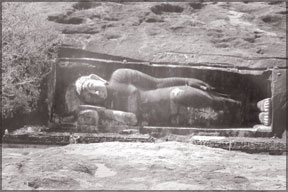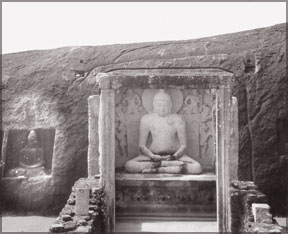Arrival of Buddhism and transformation of civilization
by Supun Perera
It was during the third century B.C. that "Anuradhagama" the present
Anuradhapura became the traditional capital under the able leadership of
King Pandukabaya.
|

Sathapena Pilima in Tantirimale |
The year exactly being 377 B.C., the sacred history chronicle "Mahavamsa"
elaborates that the island was divided into three main principalities
namely Rajarata, Ruhuna and Malayarata respectively.
Among them Rajarata has the precedence since it was concurred as the
centralised kingdom and capital city was Anuradhapura. Ruhuna was the
southern part of the island and Magama (the present Tissamaharama) was
its capital city and Malayarata, was virtually a peaceful sector though
it came in for recognition politically, in the sixth century A.D.
The founding of Anuradhapura as the capital city of Rajarata; the
scene was set for the emergence of a kingdom. A question arises as to
how did the name "Anuradhapura" be derived?. There are many stories to
support this fact.
|

The Buddha in Meditation - Samadhi Pilima |
One story reveals the issue of ninety rulers (Kings) who have adorned
this city as the capital during their respective tenure. Therefore it
was known as "ANURAJADHANIPURA", and later to "ANURADHAPURA".
However; the name is probably derived from a constellation of stars
called "ANURADHA". According to "Mahavamsa" the most sacred history
chronicle clarifies that an Indian prince named Anuradha crossed over
with five companions and founded the settlement way back in 500.B.C.
King Devanampiyatissa
The original citizens of the country are from the South Indian
territory and it was believed that these immigrants have practised the
Hinduism and worshipped numerous other Gods.
This was quite evident during the reign of king Pandukabaya when
"JAINISM" was introduced to the country. It was during the reign of King
Valagamba (Vattagamini Abaya 83 B.C. - 72 B.C.) that these "NIGANTAS"
(Jain priests) who were occupying these temples were extradited to South
India.
|

The historic Tantirimale Dagoba |
Similarly it was observed that these Nigantas never possessed noble
qualities as far as their character was concerned. Whenever there had
been a commotion in the country and especially in the kingdom of
Anuradhapura among the Royal Families who had competed for the throne.
The Nigantas exploited this situation. It no difference to present
day politics, and in return hey sneaked the information to South India
and paved the way for an imminent alien (South Indian) invasion.
The reign of King Devanampiyatissa (believed to be 305 B.C. - 267
B.C.) in 275 B.C. saw the arrival and the introduction of Buddhism by
Arahat Mahinda; the son of the Indian Emperor Dharmasoka.
The knowledge and the intelligence of the king convinced Arahat
Mahinda to spread Buddhism to Anuradhapura kingdom and later to the
entire country. Hence this opened a new era of civilisation and the
people too marched many a mile in respect to their traditional culture.
In the prag civilisation it was apparent that the subjects should
follow their leader, ruler or the chieftain with regard to the religion.
It was not known whether King Devanampiyatissa was a practising Hindu or
a Jain prior to his conversion to Buddhism.
However according to the history chronicles, it had been the
spiritual benefits of Buddhism that tempted the king to embrace
Buddhism.
With the intervention of a cultured religion the civilisation of the
entire country had a notable uplift in the settlements which had a
tremendous moral to the subjects of the country and to the future
history of it.
The advent of Rev. Sangamitta the daughter of Emperor Dharmasoka;
shortly after the departure of Arahat Mahinda laid a very firm and a
solid foundation to Buddhism and its enriched culture. Rev. Sangamitta
brought with her a sapling of the sacred "bo-tree" under which the Lord
Buddha had contemplated at Buddha Gaya in the North Eastern part of the
Indian subcontinent.
It is learned that on her way to Anuradhapura; Rev. Sangamitta had a
stay over in "Tivakkabamunugama" (the present Tantirimale) and her
arrival had sparkled with a grand welcome from the village leader named
"TIVAKKA".
Besides the historic Degoba and the bo tree; one finds the dual
postures of Lord Buddha in meditation (Samadhi Pilima) and vertical
posture (Sathapena Pilima). It is still debatable that these Buddha
statues carved on the surface of the rock belonged to the Anuradhapura
or Polonnaruwa era.
However as you get closer to these statues you need to have a very
closer look in order to make a feasible study of the same.
A detailed study and one could come to a conclusion that these stone
carvings were quite different to the one you find in Polonnaruwa, but
possess similarities to another amazing stone carving statue, SAMADHI
PILIMA... in Anuradhapura.
Some of these stone carvings were left to be completed since one
believes that it was compelled to be discontinued due to the fact that
the country had underwent a political unrest or due to a South Indian
invasion. Yet; these rock carvings; the remarkable skills of our
forefathers, is the cynosure of the travellers eye which really needs
special mention.
Religion and Civilization
The arrival of Buddhism made vast strides among the civilization in
the country. It was admirably led by King Devanampiyatissa who by
example embraced Buddhism by studying its spiritual values. As I
mentioned earlier; the subjects too followed him and it reflected a
significant turn around of events in the entire country.
As their chieftain (the Lord King) started adhering to its principles
and its enriched culture, naturally the subjects followed the suit.
The political unrest and the instability of the rulers quietly
disappeared from the kingdom and the royal families and their followers
were guided by the monastic order (Maha Sangha). The basic concepts were
evoked on them and gradually the entire nation achieved the desired
results from which they have been starved over a period of time.
As the time passed by the king sought the advice whenever there was a
crucial moment of his life or otherwise from the "sangha". Even when
there was a rift in the royal families for the throne or an uprising of
a rebellion among the subjects were entirely subsided since the monastic
order played a pivotal role to overcome these situations.
Whilst studying the basic concepts of Buddhism the king, the royal
family and its affiliates and the subjects of the country started
respecting the Maha Sangha. The king understood the importance of the
religion and therefore sacrificed most of his wealth for the uplift of
it and also became the sole protector of the establishment and defending
the same when there was an uprising or an alien invasion.
The subjects and the majority of the people trusted the king and
supported this noble endeavour with the blessings of Buddhist religious
leaders.
On account of this; the king and the royal families owed the maha
sangha a large debt. Hence; many a monumental religious structure were
erected by the successive rulers and the affiliates of royal families.
Eventually these respective religious structures were blessed and
ceremonially handed over to the monastic order and even todate these
sacred monuments could be seen in the island under the purview of
renowned Buddhist temples.
Buddhism also had two sectors of teaching. It is Theravada and
Mahayana school respectively.
Arahat Mahinda introduced the teachings of Theravada Buddhism; which
is very closer to the culture and to the routing life of the people; and
Mahayana teachings and beliefs distinguished the fact that Lord Buddha
happens to be a God and worshipped to images of Buddha and Bodhisatva.
Religion also had an impact towards the development of literature and
even todate many renowned universities in the island have introduced
numerous sacred Buddhist chronicles for their curriculum. |
